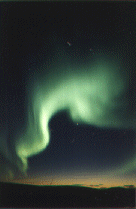 Aurora
Aurora Aurora
Auroraspaceweb@oulu.fi - last update: 18 December 1998, 1205 UT (RR)
 Geomagnetic field lines can guide energetic
electrons and protons from magnetosphere or magnetosheath down to Earth's atmosphere.
Precipitating particles loose their energy via collisions with the neutral particles and
ionize them at approximately the same altitude range than solar UV radiation when creating
the ionosphere. In addition, some of the atmospheric
constituents are excited to higher energy levels: this can lead to emission of auroral
light. Most of this activity occur within auroral oval (the major
exceptions being the sun-aligned arcs and low-latitude aurorae).
Geomagnetic field lines can guide energetic
electrons and protons from magnetosphere or magnetosheath down to Earth's atmosphere.
Precipitating particles loose their energy via collisions with the neutral particles and
ionize them at approximately the same altitude range than solar UV radiation when creating
the ionosphere. In addition, some of the atmospheric
constituents are excited to higher energy levels: this can lead to emission of auroral
light. Most of this activity occur within auroral oval (the major
exceptions being the sun-aligned arcs and low-latitude aurorae).
An often used classification divides the auroras into discrete and diffuse precipitation. In addition, while the nightside auroras reflect the dynamics of the magnetotail, dayside precipitation relates more directly to solar wind parameters. Auroras during magnetospheric substorms and, especially, the great auroras during magnetospheric storms can create extremely impressive spectacles, and it is no wonder that auroras have entered into the folklore of peoples living at high latitudes.
Primary auroral particles have energies between few tens eV and few hundred keV, being higher on the nightside than on dayside. Some of them are accelerated in the field-aligned direction, indicating the presence of a special auroral acceleration region. In general, precipitating particles loose their energies gradually by
It can be shown that for 2 keV (100 keV) electrons the maximum ionization rate occurs at the altitude of about 130 km (85 km). Also the form of the ionization altitude profile and absolute yields can be calculated. For some auroral emission lines this correlates directly with optical luminosity produced (like the first negative band of N2). Indeed, optical observations have shown that emissions of most auroras peak at about 100 km altitude. For discussion about a special type of emissio profile, see enhanced aurora.
The average ionization potential of atoms and molecules is about 15 eV. When experimental data show that fast electrons and protons produce one ion-electron pair per 36 eV, some excess energy is also left for the product electron. This leads to electron heating when the energy is being distributed among the ambient electron gas.
Optical auroral studies can be divided into two lines: spectroscopy and morphology. If the intensity of the auroral emission is high enough, colors of the emission lines can be seen by eye. For example, the most typical color, green, comes from the atomic oxygen line O1S (557.7 nm). When the chemistry of the emissions is known (not always the case), and the neutral atmosphere can be modeled, the photometric measurements of emission intensities at different wavelengths can be used to derive parameters for the incoming precipitation. The morphological features of the emissions, available when using TV or ASC (all-sky-camera), can also reveal interesting aspects of the source region. It is often said that the auroral ionosphere itself acts as a television screen for the processes taking place in the magnetosphere. The use of optical instruments is thus necessary for auroral research.
See also: